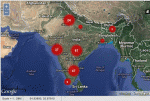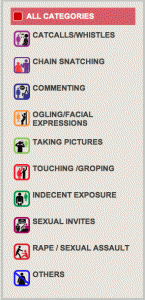
Four Indians are exposing India’s sexual harassment hotspots via Safecity, a website for victims to anonymously report when and where they were abused. The founders hope that it could be the first step to address the cultural stigma of reporting assaults.
Social entrepreneurs Alsa D’Silva, Saloni Malhotra, Surya Velamuri, and Aditya Kapoor also launched a campaign to map 100 unsafe spots in the country’s two biggest cities — where a fatal gang-rape alerted the world to the dangers women may face travelling around the subcontinent’s most populated cities.
The team created the website for women to report any type of violation, including men who take their pictures, indecent exposure, and rape. They were prompted to take action by infamous events last December, when six men travelling on a bus abducted and raped a 23-year old physiotherapy intern, who ultimately died from injuries sustained during the attack.
Safecity asks women to disclose the type of incident that took place, the time and location. Since the site was launched earlier this year there have been 185 reports from all over India, including events dating back to 1991. The reports are listed on the site and also visually represented on a Google map.
There are eight reports of rape, and the majority of complaints detail groping, ogling and inappropriate comments.
D’Silva said technology has provided a way to break the cultural stigma attached to reporting crimes.
“Police reform, judicial reform, those are all great things but given the population of the country, I don’t think the system can handle it,” D’Silva said. “We need new and innovative ways to facilitate a cultural shift.”
The crowdsourced approach has achieved mixed results in other countries.
Egypt’s HarassMap has logged over 1,200 reports since the mobile app was launched in 2010. It has helped inform volunteer efforts to address the issue, as well as raise greater awareness, however, politicians have largely ignored the site. However, a New York City Council Speaker recently helped launch New York’s Hollaback! updated mobile app, where users can anonymously log cases of sexual harassment and report these directly to Council reps.
For Safecity’s D’Silva, crowdsourcing the information starts to solve one of the major obstacles to justice for sexual assault victims: the underreporting of the crime.
Official data in India shows that rape cases have jumped almost 875% over the past 40 years — from 2,487 in 1971 to 24,206 in 2011, according to a CNN report. Comparatively, in 2010 the United States — with a third of India’s population — reported 270,000 completed, attempted or threatened rape or sexual assaults. The 90% differential is due to India’s faulty statistics, campaigners contend.
D’Silva said rape in India is underreported for three main reasons: Women are often afraid; the data is manipulated by police, who usually downgrade complaints in order to protect their performance metrics; and victims are often deterred by delayed justice in India’s clogged court system.
Safecity’s anonymous reporting mechanism is necessary to cultivate a culture that encourages women to come out, she said.
“One is the systemic issue of this being a part of our culture. The men feel it’s their right to subject women and if we stop allowing them, or giving them the liberty to do this, that’s the first step to change.”
“Also we can freely crowdsource the information, so why not do it? People should start using data for their own protection and safety. It’s not possible to only rely on the government and police for solutions.”
D’Silva is also a director at Mumbai social organisation Haiyya!, which is developing a mobile app — using skills contributed by the codeforindia project — that will send an emergency signal to other app users in the vicinity of an attack.
While technology has proven its ability to deliver increasingly efficient computer products and online applications (as well as creating endless ways to completely waste our time), Safecity, codeforindia, and even Nextdoor, among a host of others, are using these democratic digital tools to start to address fundamental social and structural problems.
These efforts often complement the dedication of volunteers in the real world.
Safecity is now looking for ten volunteers to help map 100 unsafe spots in Mumbai and Delhi, the country’s capital.
It’s a timely campaign. Last week five men raped a 22-year old Indian photojournalist in Mumbai, the country’s commercial and entertainment capital which was previously declared safe for women. D’Silva said she works very close to the isolated Shakti Mills compound in Lower Parel, where the men bound and dragged the photographer, on an assignment with a male colleague. She said that people check TripAdvisor before they visit a particular hotel or resort, and that women should take the same precautions when visiting unknown areas in India.
“We check out restaurants, move reviews, holiday destinations, so why not check out the safety rating of a new neighbourhood we’re visiting?”


